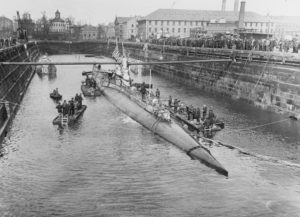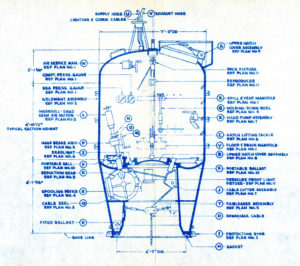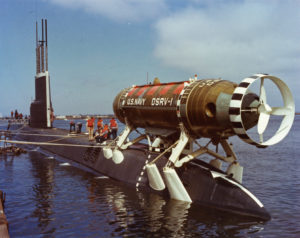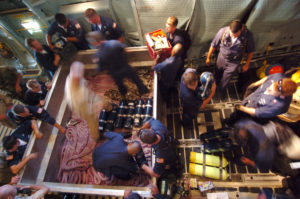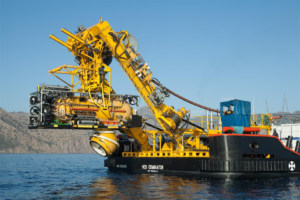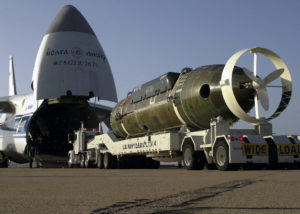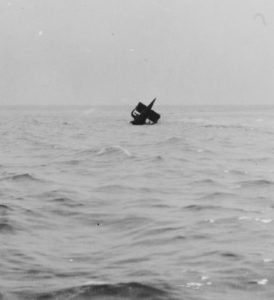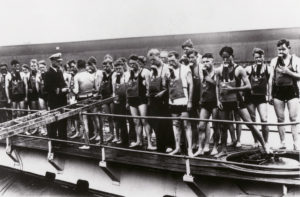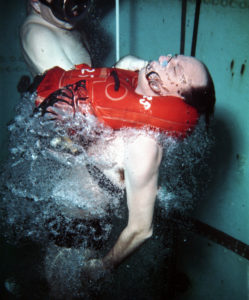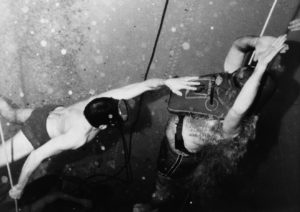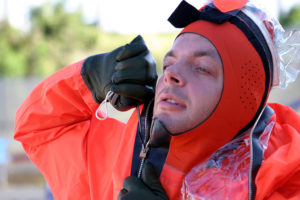Saving Submariners: Submarine Rescue and Escape
- Rescue is safer — escape methods expose survivors to hazardous conditions, like cold water and immense pressure, and are prone to mistakes.
- Rescue vehicles can operate much deeper (2,000 feet) than escape gear, which is limited to shallow water (600 feet or less).
- Rescue operations provide onsite resources, like a decompression chamber, to treat survivors.
Read on to discover how the U.S. Navy saves submariners should disaster strike.
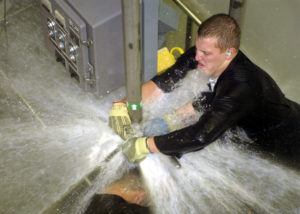 Keeping “Water Out of the People Tank”
Keeping “Water Out of the People Tank”
The best way to safeguard a submarine and its crew is to avoid or quickly halt an accident. Submariners do this through extensive training, learning to do their own jobs and everyone else’s on the sub. They also run drills to practice plugging leaks (left) and extinguishing fires. Time is of the essence — a crew must control a casualty (emergency) within five minutes to save the sub and their lives.
Possibility of Rescue
Submarines can withstand pressure to a certain depth. If a submarine sinks below this point, called crush depth, its hull will collapse under the pressure.
Although submarines spend most of their time operating in the deep ocean, they are more likely to have an accident in shallower water (due to sea trials, diving and surfacing, transiting with open hatches near port, etc.), where they can survive.
Rescue: The Go-To Approach
Until 1939, the world’s navies believed rescue had little chance of saving trapped submariners. Then the U.S. Navy raised 33 survivors from the sunken USS Squalus in May 1939 using a rescue chamber, forever changing the rescue paradigm.
Following the successful Squalus operation, the Navy embraced rescue as its preferred approach. Over time, it has developed new rescue technology that continually improves its rescue abilities.
“Is There Any Hope?”
On December 17, 1927, Coast Guard destroyer Paulding struck surfacing submarine USS S-4. Salvage boats hurried to raise the submarine in hopes of saving the crew. Divers located six survivors by tapping on S-4’s hull, but weather thwarted all efforts to move the sub. Sixty hours into the operation, the trapped men tapped “Is there any hope?” Heartrendingly, the divers answered “no.” All 40 crew died in the accident.
Submarine Rescue Chamber
In service 1930s–Present
Commanders Charles Momsen and Allan McCann co-designed the submarine rescue chamber (SRC) after S-4’s loss. In less than 850 feet of water, a salvage ship can lower a rescue chamber to a disabled submarine to raise survivors to the surface. The Navy has used a chamber once for an actual rescue, to save 33 submariners from USS Squalus in 1939. Today the SRC remains part of the Navy’s rescue arsenal because its simple design makes it effective and reliable.
Rescue Gets Cutting-Edge: The DSRVs
In service 1970–2008
With the 1963 sinking of USS Thresher (SSN 593), the Navy realized submarines were operating deeper than rescue equipment could reach. The deep-ocean program it formed in response designed two sophisticated rescue submersibles called DSRVs (deep submergence rescue vehicles). When needed, a DSRV could be rapidly deployed by sea, air, or land to rescue submariners anywhere in the world. DSRVs Mystic and Avalon were launched in the early 1970s, given full operational status in 1977, and served as the Navy’s submarine rescue system through 2008.
Inside a DSRV’s outer fiberglass hull, three high-strength steel spheres formed the pressure hull. Two pilots operated the DSRV from the forward sphere, while the mid and aft spheres could hold one rescuer and 12 submariners.
At a rescue site, a specially-configured submarine or a submarine rescue ship carried the DSRV close to the sub. The DSRV could then descend, attach to the submarine’s escape hatch, and transfer rescued submariners to the support vessel in groups of 24.
The Rescuers
Who rescues the submariners on a disabled sub?
Initially, any ship that encountered the submarine (often the ship that collided with it). With its establishment in 1927, the Navy Experimental Diving Unit became the first command responsible for submarine rescue.
The Navy created a dedicated command, the Submarine Rescue Unit, after its new rescue vehicles (DSRVs) entered service in the 1970s. Rebranded over time, the unit became the Deep Submergence Unit in 1989 and received its current name, the Undersea Rescue Command, in 2012.
Rescue Today: The SRDRS
In service 2008–Present
In 2008, the Navy adopted an updated rescue system, the Submarine Rescue Diving and Recompression System (SRDRS). The SRDRS carries out an operation in three parts:
- Reconnaissance — examining the downed sub’s conditions with an atmospheric diving suit
- Rescue — raising survivors using a rescue module named Falcon
- Decompression — transferring the crew from Falcon to a decompression chamber to avoid uncontrolled pressure changes
As an easily transportable “fly-away” system, the SRDRS is easier and faster to deploy than its predecessors, the DSRVs.
International Collaboration
The Navy’s modern rescue systems, including the DSRVs and the current SRDRS, are purposely compatible with the submarines and rescue systems of navies throughout the world. The U.S. Navy regularly takes part in rescue exercises with other nations and has official submarine rescue partnerships and agreements in place with more than 40 countries.
Escape: The Backup Option
Escape offered the earliest means of saving crew members inside a downed submarine. With the introduction of the first rescue equipment, the submarine rescue chamber in 1939, rescue became the safer, preferred choice.
Although escape is now a last resort, submarines still train in escape methods. A crew may need to attempt an escape in cases where a rescue is impossible or significantly delayed.
Impromptu Escapes
Between 1900 and 1930, the U.S. Navy lost eight submarines to accidental sinkings. The only rescue option at the time, raising the submarine before oxygen ran out, saved two men. But the majority of those who survived — 84 submariners — lived because they found ways to escape their sunken subs.
On August 30, 1920, USS S-5 flooded and sank — with no means of being found underwater. Her crew cleverly refloated her aft compartments to raise the stern to the surface. Nearby ships sighted the disabled sub and provided breathing air and water while S-5’s crew cut a hole in the pressure hull, saving all 38 aboard.
Escape Gear
Crew members attempting an escape face a slew of hazardous conditions — a compromised environment inside the disabled sub and a cold, immensely pressurized environment outside it. Escape gear must help submariners survive in these variable circumstances while minimizing the operator error to which it is inherently prone.
Momsen Lung
In service 1928–1956
The Momsen lung was the world’s first successful submarine escape device. Worn around a submariner’s neck, it recycled exhaled air by removing carbon dioxide and gave its wearer some floatation on the surface. When used without sufficient skill and training, it could cause death from lack of oxygen, air embolism (lung rupture), carbon dioxide poisoning, or drowning.
In October 1944, nine submariners survived the sinking of USS Tang (SS-306) using Momsen lungs.
Free Ascent
In use 1956–1963
The Navy adopted the free ascent escape technique in 1956. The approach trained submariners, outfitted with simple lifejackets, to exhale continuously while swimming to the surface. Although safer than the Momsen lung, the free ascent technique still carried risk — accidentally inhaling could cause a lung rupture or an arterial air embolism (an air bubble in a blood vessel).
Steinke Hood
In service 1963–2007
The Steinke hood was the Navy’s standard escape equipment throughout the Cold War. Named for its inventor, Lt. Harris Steinke, the Steinke hood allowed escapes from 300 feet or less. The inflatable lifejacket’s attached hood enclosed the escaping sailor’s head, providing air during the ascent. This allowed its wearer to breathe normally (in as well as out), reducing panic and threat of air embolism.
Escape Suit
In service 2005–Present
Today the Navy uses full-body escape suits that support escape from depths up to 600 feet. Originally developed by the British Navy, they resolve many issues found in past escape equipment, including threat of air embolism and lack of thermal protection. The current suit, the Mark 10 submarine escape immersion equipment (SEIE) suit, has a built-in life raft and a thermal insulation liner that protects against decompression sickness, hypothermia, and fatigue.
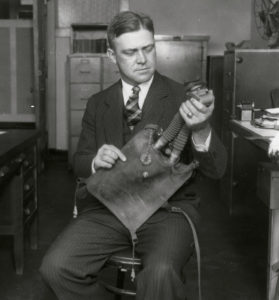 Charles Momsen
Charles Momsen
1896–1967
Charles “Swede” Momsen pioneered submarine rescue within the U.S. Navy. As a young lieutenant, he watched the crews of S-51 (1925) and S-4 (1927) suffocate inside their downed submarines because the Navy had no way to save them. Momsen reacted by inventing the Momsen lung (a wearable breathing device) in 1928 and the submarine rescue chamber in the 1930s — life-saving devices became his legacy.
Momsen personally tested the Momsen lung, making repeated practice escapes from up to 200 feet underwater. The Navy awarded him the Distinguished Service Medal for this work in 1929, praising his initiative and courage and calling the lung “the greatest single contribution to Submarine escape.”
Historical Rescues and Escapes
Out of nineteen accidental (non-combat) submarine sinkings, nine accidents saw survivors that lived by escaping their submarines, being rescued, or a combination of the two:
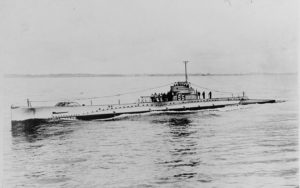 USS S-5
USS S-5
September 1, 1920 | USS S-5 sank after her forward compartments flooded. The crew refloated her aft section to raise her stern above water. Found by two steamships that provided air and water, S-5’s crew cut an escape hole in her hull. All 38 crew lived.
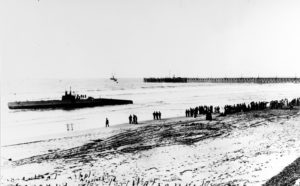 USS F-1
USS F-1
December 17, 1920 | USS F-1 was hit by her sister sub F-3 while performing an engineering test. The resulting flooding killed 19 crew inside F-1. Five men on F-1’s bridge survived to be picked up by F-3.
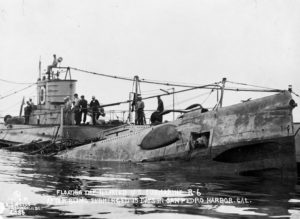 USS R-6
USS R-6
September 26, 1921 | An open torpedo tube door flooded USS R-6, drowning two crew members. The shallow-water sinking allowed the remaining 18 men to escape.
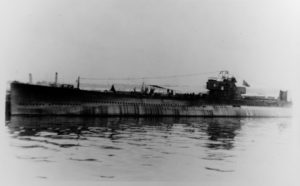 USS S-48
USS S-48
December 7, 1921 | USS S-48 flooded and sank during builder’s trials after a ballast tank opening was left uncovered. The crew blew the forward ballast tanks to raise S-48’s bow about the surface, allowing them to climb out the torpedo tubes. All 41 survived.
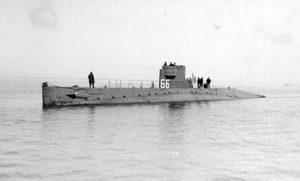 USS O-5
USS O-5
October 28, 1923 | USS O-5 Sank in 30 feet of water after being struck by freighter. Three drowned inside the flooded torpedo room. One man survived by building pressure in airlock, propelling him to the surface. Floating cranes brought in to raise sub allowed the remaining 17 crew to escape.
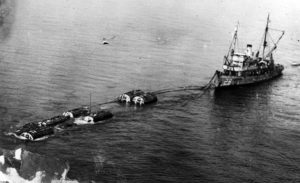 USS S-51
USS S-51
September 25, 1925 | Merchant steamer City of Rome collided with USS S-51 at night. Three men on S-51’s bridge jumped into water and were rescued. S-51 sank 132 feet underwater; with no means of rescue, 33 crew suffocated inside the downed sub.
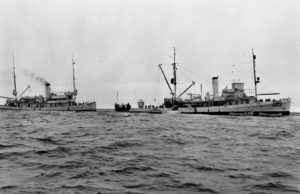 USS Squalus
USS Squalus
May 23, 1939 | USS Squalus flooded and sank to a (then) record 243 feet deep. Twenty-six drowned in her flooded aft compartments. Charles Momsen led the rescue operation, the first true Navy submarine rescue, saving 33 survivors with submarine rescue chamber.
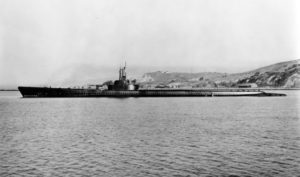 USS Tang
USS Tang
October 24, 1944 | USS Tang was struck by her own torpedo during her fifth World War II patrol and sank to 180 feet deep, her aft compartments flooded. Seventy-three crew died with Tang. Thirteen escaped using Momsen lungs, while ten on her bridge abandoned ship. Only nine men survived.
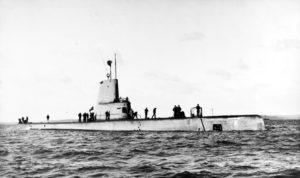 USS Cochino
USS Cochino
August 25, 1949 | USS Cochino suffered an electrical fire and battery explosion from a severe storm. Her crew tried to save the ship until a second explosion forced their evacuation. During the transfer to USS Tusk, one Cochino civilian and six Tusk crew drowned. The remaining 76 from Cochino survived.

